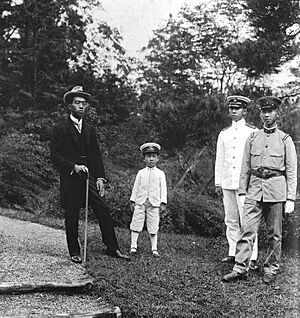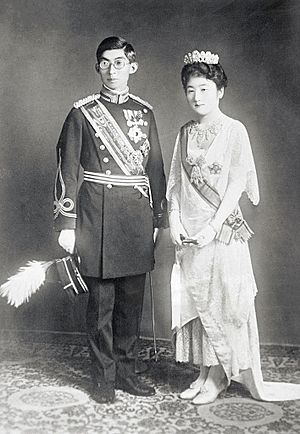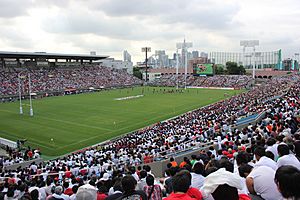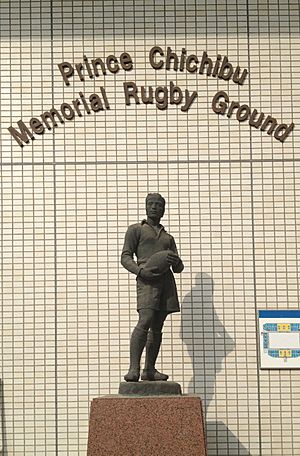Yasuhito, Prince Chichibu facts for kids
Quick facts for kids Yasuhito |
|||||
|---|---|---|---|---|---|
| Prince Chichibu | |||||
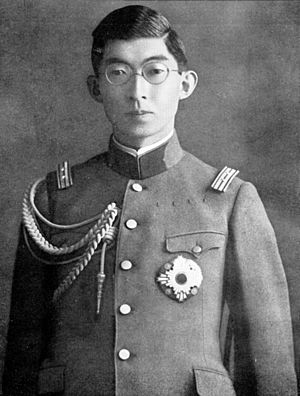
Prince Chichibu in December 1940
|
|||||
| Born | 25 June 1902 Aoyama Detached Palace, Tokyo City, Japan |
||||
| Died | 4 January 1953 (aged 50) Kugenuma Villa, Fujisawa, Kanagawa, Japan |
||||
| Burial | 12 January 1953 Toshimagaoka Imperial Cemetery, Bunkyo, Tokyo |
||||
| Spouse | |||||
|
|||||
| House | Imperial House of Japan | ||||
| Father | Emperor Taishō | ||||
| Mother | Sadako Kujō | ||||
| Military career | |||||
| Allegiance | |||||
| Service/ |
|||||
| Years of service | 1922–1945 | ||||
| Rank | |||||
| Commands held | 31st Infantry | ||||
| Battles/wars | Second Sino-Japanese War Second World War |
||||
Yasuhito, Prince Chichibu (秩父宮雍仁親王, Chichibu-no-miya Yasuhito Shinnō, 25 June 1902 – 4 January 1953) was a Japanese prince. He was the second son of Emperor Taishō and Empress Teimei. He was also a younger brother of Emperor Shōwa (Hirohito).
Prince Chichibu was an important member of the Imperial House of Japan. He supported many sports, medical groups, and international exchange programs. He and his wife, Princess Chichibu, worked to build good relationships between Japan and the United Kingdom. They were also good friends with the British royal family. Like other princes of his time, he served as an officer in the Imperial Japanese Army.
Contents
Prince Chichibu's Early Life and Family
Prince Yasuhito was born on June 25, 1902, in Tokyo. He was the second son of Crown Prince Yoshihito (who later became Emperor Taishō) and Crown Princess Sadako (who later became Empress Teimei). His first title was Atsu no miya, meaning Prince Atsu.
When he was young, Prince Yasuhito and his older brother, Hirohito, lived with a respected naval officer, Count Sumiyoshi Kawamura, and his wife. After Kawamura passed away in 1904, the young princes moved back with their parents.
He went to the Gakushuin Peers' School. His older brother, Crown Prince Hirohito, and younger brother, Prince Nobuhito, also attended this school. In 1917, Prince Chichibu joined the Central Military Preparatory School. He then entered the Imperial Japanese Army Academy in 1922.
On May 26, 1922, Emperor Taishō gave his second son the title Chichibu no miya. This allowed him to start a new branch of the imperial family. In 1925, the Prince traveled to Great Britain to study at Magdalen College, Oxford. While there, King George V gave him a special award called the Grand Cross of the Royal Victorian Order. Prince Chichibu was known for enjoying outdoor activities and mountain climbing during his time in Europe.
He returned to Japan in January 1927 because his father, Emperor Taishō, had passed away. For a time, Prince Chichibu was next in line to the throne. This changed when his nephew, Crown Prince Akihito, was born in December 1933.
Marriage and Family Life
On September 28, 1928, Prince Chichibu married Matsudaira Setsuko. Her father, Matsudaira Tsuneo, was the Japanese ambassador to the United States and later to Great Britain.
Princess Setsuko was from an important family, the Matsudaira of Aizu. This family was connected to the Tokugawa shogunate, which ruled Japan for many years. Prince and Princess Chichibu did not have any children.
Military Service
Prince Chichibu became a second lieutenant in the infantry in October 1922. He was part of the First Imperial Guard Division. He was promoted to first lieutenant in 1925 and became a captain in 1930. In August 1935, he was promoted to major and commanded the Thirty First Infantry Division. In March 1945, he became a major general.
In 1937, the prince and his wife went on a tour of Western Europe. They attended the coronation of Britain's King George VI and Queen Elizabeth in May 1937. They also visited Sweden and the Netherlands.
Prince Chichibu also visited Nuremberg in Germany. There, he met Adolf Hitler. He tried to improve relations between Japan and Germany. However, he later told his aide that "Hitler is an actor, it will be difficult to trust him."
During World War II, Prince Chichibu was involved in military operations. He was sent to Manchukuo and Nanjing. According to his wife's memoirs, he retired from active duty in June 1940. This was because he was diagnosed with tuberculosis. He spent most of the war recovering at his home in Gotemba.
Supporting Sports and Other Activities
After World War II, Prince Chichibu became the honorary head of many sports organizations. He was known as the "sporting Prince." He worked hard to promote skiing, rugby, and other sports in Japan.
He was also the honorary President of the Japan–British Society and the Swedish Society of Japan. He supported Scouting in Japan and attended an international scouting conference in 1926.
Prince Chichibu was very important in helping rugby union in Japan grow. After his death, the Tokyo Rugby Stadium was renamed Chichibunomiya Rugby Stadium in his honor. A statue of Prince Chichibu in rugby gear stands there today.
Later Life and Passing
Prince Chichibu passed away from tuberculosis on January 4, 1953. He was at his home in Fujisawa, Kanagawa. His remains were cremated, and his ashes were buried at Toshimagaoka Cemetery in Bunkyō, Tokyo, on January 12, 1953.
Images for kids


